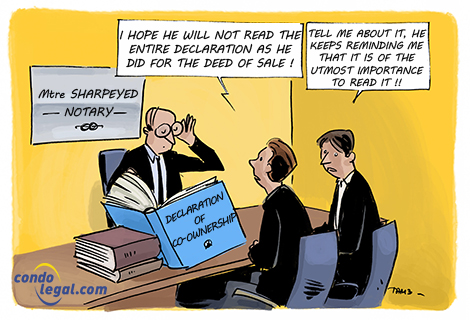
The Act respecting duties on transfers on immovables obliges local municipalities to collect a duty on the transfer of any immovable situated on their territory. Taxable to the purchaser, this right is called "welcome tax" not to qualify a sign of hospitality but in memory, perhaps a little in derision, of the minister of municipal affairs at the time, Jean Bienvenue. It is a significant source of revenue for municipalities. As a general rule, the duties on transfer of immovables tax account will be sent to you a few weeks after your acquisition. You will then have thirty (30) days to pay it.
Before acquiring a property, it would therefore be wise to provide for the payment of this right, in your budget in the same way as notary and real estate brokerage fees. Must appear at any request for registration of a transfer in the land register, the amount payable is generally provided for in the deed of sale. It should be noted, however, that the treasurer of the municipality has the power to revise the amount payable if he considers that it has been incorrectly calculated. This situation frequently occurs, in the context of the purchase of a new property for which the assessment roll does not yet include any entry of value, an information necessary for the calculation of the right. Keeping the roll up to date will then allow the treasurer to calculate the transfer duty in accordance with the Act.
The calculation of transfer duties
The amount of the duty to be paid is generally the product of the tax base, which is the counterpart value of the building and the rate provided for by law.
The tax base will generally be the higher value between the amount paid by the buyer (excluding GST and QST) and the market value of the immovable, which is equivalent, according to the Act, to the standardized value entered in the assessment roll at the time of the sale. The applicable rate is that provided for in the scale contained in section 2 of the Act on the amount paid or the market value, by adding the total of each value of bracket:
|
• 0.5% on the first $ 53,200 |
|
|
1.5% on the amount exceeding $ 266,200 |
The adoption of Bill 122, on June 15, 2017, granted more latitude to municipalities in the scale of value brackets. Thus, a municipality may, by by-law, set a rate higher than that provided for in subparagraph 3 of the first paragraph (1.5% from $264,000) for any portion of the tax base that exceeds $500,000. A rate set under this paragraph may not, however, except in the case of Ville de Montréal, exceed 3%. This means that a municipality can apply its own tax brackets for amounts over $500,000 as long as it does not exceed this limit.
If you buy in Montreal, the tax brackets are as follows:
|
|
|
|
|
|
To better understand how to calculate the applicable value of a transfer duty, the example shown below gives a good overview. For a property located in a municipality applying the basic rates as provided for in the Act respecting duties on transfers of immovables whose value is $350,000, the amount of the transfer duties is calculated as follows:
|
|
|
It is important to know that the Law allows for the annual indexing of the brackets of the tax base provided for in article 2 in the amount applicable for the previous financial year (calendar year) by a percentage corresponding to the rate increase, according to the l'Institut de la statistique du Québec, in the overall consumer price index for Quebec. The Ministry of Municipal Affairs and Housing generally publishes this indexation rate six months in advance. Thus, it is thus provided that the tax brackets for 2021 will be increased for the year 2022 by 0.8352%. It is therefore useful to check beforehand the increase in the tax brackets so you are not to be taken by surprise when the new financial year arrives.
Exemption
The Law provides for several cases of exemption. Thus, the purchaser is exempt from paying property transfer duties if the tax base is less than $5,000. This is also the case between certain transfers between parents:
An exception to the exemption applies with respect to the transfer made to a descendant when the transferor (the one who transferred) acquired the immovable, either from a descendant in direct line, or from a trust which acquired the immovable from such a descendant, and that the transferor has not retained ownership of the immovable for at least two years after this acquisition, unless the transfer results from the death of the transferor or if the immovable is transferred to the person or trust from whom it was acquired. It is therefore imperative during a transfer between descendants to ensure that the transferor has had possession of the building for at least two years in order to benefit from the exemption from transfer duties.
Other exemption situations are provided; thus, certain transfers with or between related legal entities. Although it has only about thirty articles, reading the Act respecting duties on transfers of immovables is not easy. A lawyer will be able to tell you if they apply to your transfer.
 WHAT YOU SHOULD KNOW! Following the adoption of Bill 122 in 2017, municipalities may now, by by-law, set a rate higher than that provided for any portion of the tax base that exceeds $500,000 as long as it does not exceed 3% (only Ville de Montréal has the possibility to impose a tax greater than 3% as provided by the law).
WHAT YOU SHOULD KNOW! Following the adoption of Bill 122 in 2017, municipalities may now, by by-law, set a rate higher than that provided for any portion of the tax base that exceeds $500,000 as long as it does not exceed 3% (only Ville de Montréal has the possibility to impose a tax greater than 3% as provided by the law).
 WHAT TO KEEP IN MIND: Transfers between brothers and sisters are not exempt from transfer duties.
WHAT TO KEEP IN MIND: Transfers between brothers and sisters are not exempt from transfer duties.
 WARNING! If the exemption is applicable, the municipality may still require that failing a transfer duty, a supplementary fee be paid. The supplementary fee is financial compensation required by a municipality that usually do not exceed $200.
WARNING! If the exemption is applicable, the municipality may still require that failing a transfer duty, a supplementary fee be paid. The supplementary fee is financial compensation required by a municipality that usually do not exceed $200.



